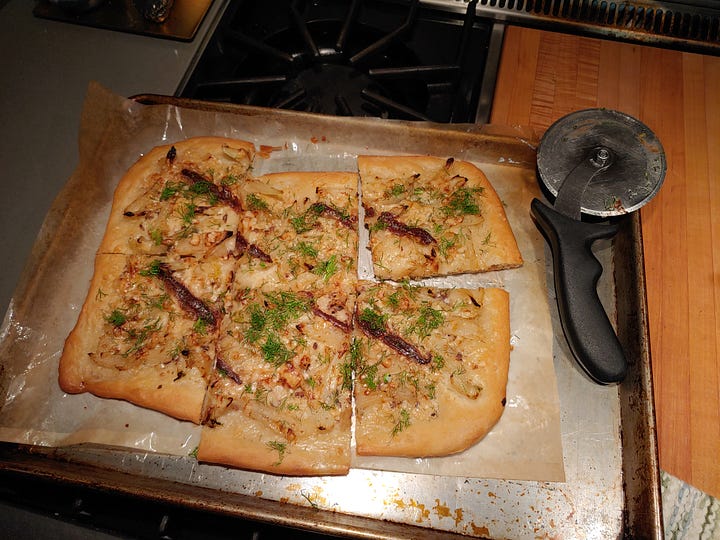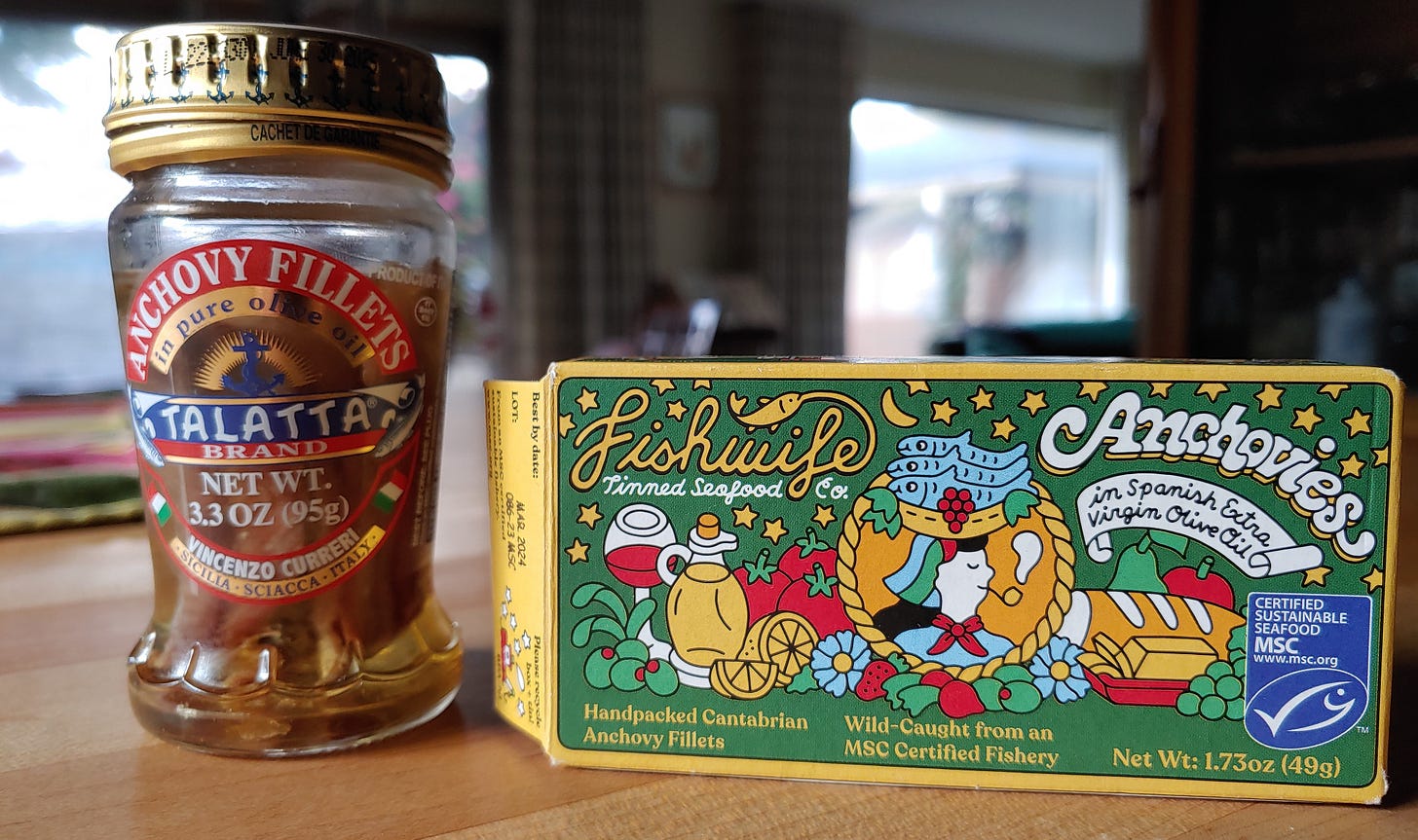Learning to love (maybe???) anchovies
On efforts to expand my anchovy horizons, a quick anchovy poll, a bit more about cookbooks, and flatbread with fennel and anchovies (to prove that I’m trying)
A couple of weeks ago, something nudged me to consider that I should give anchovies a bit more attention. I’ve rather actively avoided them for most of my life, finding their intense salty-fishy flavor just too overpowering to be enjoyable. I’ve never wished to have anchovy fillets draped over my Caesar salad nor invited them onto a pizza I’m ordering, though I don’t mind a hint of anchovy in a salad dressing or pasta sauce.
Well…there actually was a brief phase of embracing anchovies while I was writing Salty Snacks a dozen-plus years ago. The salt-cured little fillets were a natural to include in that book. For one recipe, I made retro anchovy crisps, using flattened white sandwich bread, spread with an anchovy-butter mixture and toasted until crisp. The other was a bagna cauda served with pieces of fennel bulb to dip in the warm anchovy-and-garlic enhanced olive oil. (This recipe was the spark of inspiration for the flatbread recipe below.) Once that book’s recipe testing was done, the little jars got lost behind others in the fridge door and I forgot about them again. And didn’t miss them one bit.
That nudge has taken on a life of its own since I posed this question to folks online last week:
how do you feel about anchovies? love them? avoid them? or middle ground, like me, fine with them when not too prominent in a dish?
Wow.
I had a feeling a lot of people liked anchovies. I wasn’t quite prepared for the degree of glee and enthusiasm shared in response to the question. An overwhelming majority of my friends and colleagues are seriously into anchovies. “Eating anchovy toast as I type. LOVE them,” wrote one. Another said he has to buy 2 little jars as a time because he can go right through the first one as soon as it’s open. A number of folks referenced a couple butter-enhanced options (a good ploy to get my attention!): cooking them in butter until they fall apart, then tossing in pasta; and slathering bread with butter then topping with anchovy. And others mentioned the value of a flavor pop, the umami hit that anchovies add to so many recipes (something I know I’ve been missing out on all these years).
A couple days ago I came across, and cooked, a pot roast recipe that included 10 anchovy fillets, which meld fully into the cooking liquids over the few hours of braising, and add a subtle je ne sais quoi to the finished dish. That’s definitely staying in my repertoire. It and the recipe below are the beginning of a long list of new anchovy adventures I’ll be pursuing. My husband will be thrilled. He never had to acquire a taste for anchovies, he’s loved them for as long as he can remember. (I bought that tin of Fishwife anchovies for him…then took it back for recipe testing!)
Getting the most out of your cookbook collection
For those of us with a large collection (I realize ‘large’ is subjective, 200+ maybe?) of cookbooks, it can be a little challenging to make good use of even a decent percentage of them all. The potential for missing out on recipe gems to be found where I might not expect them is high. I might turn to the shelf with the French cookbooks when looking for bouillabaisse recipes, overlooking some great versions to be found in books I never would have thought to check. And as mentioned in the last newsletter, for seafood inspiration you certainly don’t need to rely only on the seafood-specific books on your shelf.
To help us make the most of our cookbooks, the website Eat Your Books was launched in 2009. I was lucky to be among the early adopters and have been a huge fan from early on. The site’s resources have grown over the years and continue to expand—at its core the site is a searchable index of recipes that you customize to focus on those available in your cookbooks. Once you’ve entered titles of those books on the site, when you search for recipes under the “My Bookshelf” tab, you’ll be given a list of recipes found in your books that match the search. Your search can be based on a key ingredient or a particular recipe (cioppino, cherry cobbler), and you can search with a couple ingredients from the fridge that need some attention to get some ideas. If it’s a search that turns up a whole lot of recipes, you can choose options for sorting (such as based on EYB community input) or filtering (i.e. just appetizers) to help find ideal options.



In the spirit of expanding my anchovy appreciation, I just put in ‘anchovies’ and find that there are nearly 1500 recipes from among my 564 cookbooks that include anchovies. That should keep me busy for a while! Among them is Scotch Woodcock (scrambled eggs on anchovy toast) from The Cooking of the British Isles in the beloved Time-Life Foods of the World series. And James’ Broccoli with Burrata, Pine Nuts and Warm Anchovy Vinaigrette from Sunday Suppers at Lucques by Suzanne Goin. And one from celebrated English writer Jane Grigson for Potatoes Gratin with Anchovies in her book The Mushroom Feast, tucking 2 tins’ worth (!!) of anchovies among the layers of sliced potatoes and mushrooms.
I’m already starting to like the idea of all this anchovy exploration much better. Eat Your Books is a great tool to make those kinds of discoveries easy and truly to help you get the most out of all those fabulous cookbooks you own.
To clarify, recipe searches on the website provide you with a quick preview—the recipe name, title/author of the book, and list of at least the key ingredients. There may also be some notes and reviews related to the recipe. This isn’t replacing the recipe sources surrounding you, instead pointing you to them to get all the recipe details and the full experience the author provides in those pages.
Flatbread with Fennel and Anchovies
As noted above, this recipe is inspired by bagna cauda, which is often served with an array of raw or lightly cooked vegetables for dipping into the warm anchovy- and garlic-enhanced olive oil (the recipe name means “hot bath” in Italian). For the version included in Salty Snacks, I served it with just fresh fennel bulb, adding some of the finely chopped fennel fronds to the oil as well. I riff on that combo in flatbread form here, no bath or dip going on. A mixture of olive oil, anchovy, and garlic is spread over the dough, and topped with sautéed fennel, Parmesan cheese, and whole anchovy fillets.
The newer generation of tinned seafoods in recent years is elevating our anchovy options beyond the traditional jars and tins we’ve seen on grocery shelves for so long—Fishwife among them. Because I had these two brands of anchovy on hand, I used both when testing the recipe: those from the jar for the oil mixture, saving the Fishwife anchovies for those used on top.
When shopping, try to choose a fennel bulb with some nice tender fronds, to be chopped and scattered over the flatbread before serving. Not a problem if your bulb is lacking them; you can finish with a sprinkling of chopped parsley or chives instead, or just skip the herbs.
Feel free to use your favorite pizza dough recipe instead, or pick up some prepared dough at the grocery store (often in the freezer section) or maybe a local bakery (I’ve seen, but not yet tried, pizza dough available at Grand Central Bakery in my neck of the woods) .
For the anchovy-timid, you can skip the whole fillets added on top; the anchovy flavor that comes through from the mixture spread on the dough is rather subtle. A baby step for you, and for me!


Flatbread with Fennel and Anchovies
5 tablespoons olive oil
1/2 large or 1 small fennel bulb, trimmed, cored, and cut into 1/4 inch slices
4 anchovy fillets, finely chopped, or 2 teaspoons anchovy paste
1 tablespoon finely minced or pressed garlic
1/2 cup thinly shaved or coarsely grated Parmesan cheese
4 to 6 (or more if it makes you happy!) whole anchovy fillets
3 to 4 tablespoons chopped fennel fronds, if you have some
Pizza Dough
1 3/4 cups all-purpose flour
1 teaspoon instant yeast
1 teaspoon kosher salt
2/3 cup warm water
For the pizza dough, combine the flour, yeast, and salt in the bowl of a stand mixer fitted with the hook attachment. Stir the dry ingredients to blend, then stir the warm water and mix on medium-low to form a smooth dough. Continue mixing at medium until the dough is supple and a bit elastic, 6 to 8 minutes. You can mix the dough and knead by hand if you prefer. Form the dough into a tidy ball, lightly oil the bowl and the dough, cover the bowl with plastic wrap, and set aside in a warm place until doubled in bulk, about 1 hour.
While the dough is rising, heat 2 tablespoons of the olive oil in a medium skillet over medium heat. Add the sliced fennel and cook, stirring occasionally, until beginning to soften, about 5 minutes. Cover the skillet, reduce the heat to medium-low, and continue cooking until the fennel is tender but not starting to fall apart, about 15 minutes longer. Stir now and then to ensure even cooking, and reduce the heat if it’s browning more than just a little bit. Set aside to cool.
When the dough has risen, punch it down, reform it into a tidy ball and cover again; set aside for a second rise, about 30 minutes. In a small bowl, stir together the remaining 3 tablespoons of the olive oil, chopped anchovy or paste, and garlic.
Preheat the oven to 475 F, with a pizza stone in the oven to preheat as well (if not using a stone, see Note below).
Turn the dough onto a lightly oiled piece of parchment paper. Press and gently stretch the dough with your flattened fingers, working from the center outward, to form a roughly 9- by 12-inch rectangle or 12-inch circle. If the dough becomes hard to stretch, springing back a lot, let it sit to relax for a few minutes, then continue.
Transfer the parchment paper and dough to a pizza peel, an unrimmed baking sheet, or an upside-down rimmed baking sheet. Stir the anchovy-oil mixture, spoon it over the dough and spread it out with the back of the spoon, leaving the outer edge bare. Scatter the sliced fennel evenly over, followed by the Parmesan cheese, and top with the anchovy fillets.
Carefully slide the parchment and dough onto the heated pizza stone and bake until the dough is well puffed and browned around the edges, 8 to 12 minutes. When the pizza is ready, take it from the oven and let sit a minute. Scatter the fennel fronds over, cut into pieces, and serve.
Makes 2 to 4 servings
Note: If you’re not using a stone, line a rimmed baking sheet with a piece of parchment paper, lightly oil the paper, and form the dough and add toppings as noted above.






